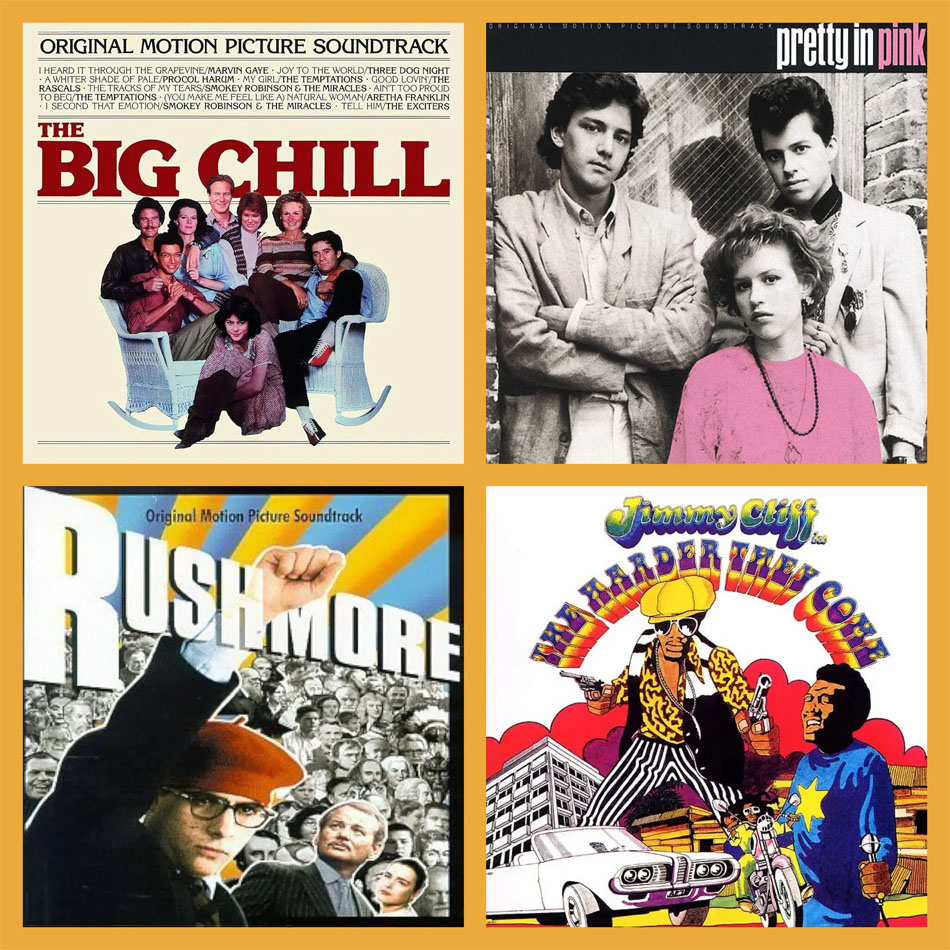By Doug Boilesen
The
first movies seen by the public using
Edison's Kinetoscope in
1894 were without sound. Edison's intent from the beginning, however,
was that recorded sound should be part of a multimedia "moving
pictures" experience.
Edison
had hoped to introduce his moving picture "Kinetoscope"
at the 1893 World's Columbian Exposition and had promoted it as something
which would include sound. His Kinetoscope 'peep-show' entertainer
was not ready before the Exposition ended, and when the first Kinetoscope
Parlor was opened on April 14, 1894 in New York City the phonograph
was still not part of Edison's moving picture device.
The
First Soundtracks
In
1895 Edison introduced his Kinetophone (a combination Kinetoscope
and Phonograph, also known as the Phonokinetoscope) with its peep-show
viewer for watching the moving pictures and ear tubes for listening
to the phonograph. "Most, and probably all, of the films marketed
for the Kinetophone were shot as silents, predominantly march or dance
subjects." These movies created for Edison's kinetophones, however,
did allow exhibitors of Kinetophones to "choose from a variety
of musical cylinders offering a rhythmic match." (Altman, Rick,
Silent Film Sound, (2007), pp. 81–83; Hendricks,
Gordon, The Kinetoscope: America's First Commercially Successful
Motion Picture Exhibitor. (1966), pp. 124–25).
The cylinder records selected
and played by the kinetophone exhibitors, therefore, could be called
the first soundtracks of the movies. For example, suggestions
of "three different cylinders with orchestral performances
were proposed as accompaniments for Carmencita: "Valse Santiago",
"La Paloma", and "Alma-Danza Spagnola." -
(Wikipedia, Guida practica (1895–96), p. 126 [p. 348 in Light
and Movement]). Since Emile Berliner patented the 'Gramophone'
in 1889 it wouldn't have been an anachronism to have Grammy Awards
in 1895 so perhaps one of those recordings could have won the "1895
Grammy Award for Best Score Soundtrack for Visual Media."
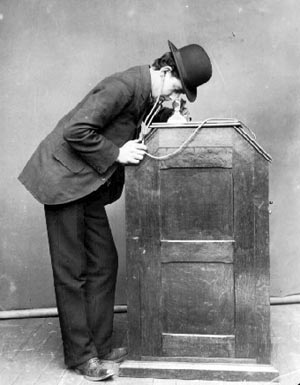
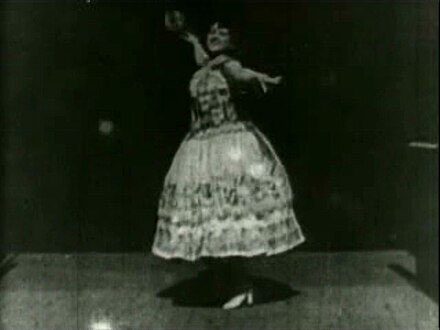
Screenshot from Carmencita,
the 1894 Edison short named for the featured dancer of the film, could
have been seen and heard on a Kinetophone in 1895.
WATCH
Carmencita (Source: Library of Congress).
LISTEN
to La Paloma by the Edison Symphony Orchestra, Edison 2-minute
Cylinder Record Number 565, Released 1902 (David Giovannoni Collection).
The Kinetophone was unsuccessful
with only "forty-five of the machines were built over the next
half-decade." (Musser,
Charles, The Emergence of Cinema: The American Screen to 1907,
(1994), p. 88.)
The
First Projected Movies
The first public screening
which projected moving pictures was by the Lumière brothers (Louis
and Auguste) using their Cinématograph on December 28, 1895 at the
Grand Café in Paris. Projected moving pictures would soon dominate
the way moving pictures were watched and significantly impact the
kinetoscope market.

"Wants and For
Sale," The Phonoscope, April 1897
The trade magazine The
Phonoscope reported in their November 1897 issue that the Frenchmen
had already bettered the peep-show kinetoscope and in a few years
their projection system will be perfected:
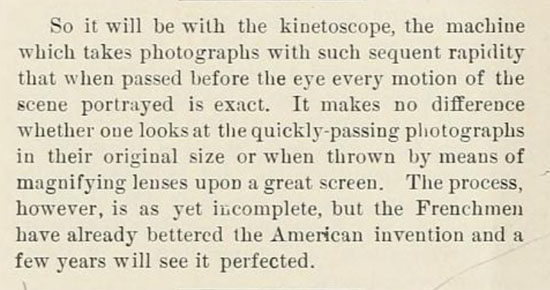
The Phonoscope,
November 1897
Projected
Feature-length Movies
In 1906, the first feature-length
silent film titled "The Story of the Kelly Gang" was produced
in Melbourne, Australia. The film was directed by Charles Tait and
was about the outlaw Ned Kelly and his gang. "In
2007, "The Story of the Kelly Gang" was inscribed on the
UNESCO "Memory of the World Register" for being the world's
first full-length narrative feature film." Wikipedia.
William S. Porter's 12-minute
"The Great Train Robbery" released in December 1903 and
distributed by the Edison Manufacturing Company has often been called
"the first Western or even the first film to tell a story."
Film scholars, however, "have repeatedly disproved these
claims." Nevertheless, "its commercial success and
mythic place in American film lore nonetheless remain undisputed....In
1990, "The Great Train Robbery" was selected for preservation
in the United States National Film Registry by the Library of Congress
as being "culturally, historically, or aesthetically significant".
Wikipedia (extracted 7-10-2024).
Projected silent movies
would continue to thrive and recorded sound would take some time to
become an expected part of the movie-goers experience.
Projected
Movies and synchronized recorded sound
Leon Gaumont's projector,
the Chronophone, was introduced in 1902 which successfully produced
"several hundred Phono-Scenes by 1912 which used his projector
and a synchronized gramophone sound system.
Leon Gaumont's Chronophone, a
system that used a rheostat to synchronise the speed of a projector
with that of a gramophone, was introduced in 1902, and by 1912 he
had produced several hundred Phono-Scenes, mostly popular songs
or extracts from operas and ballets. Sound effects were common in
fairground performances, and in cinemas, actors would sometimes
be concealed behind the screen, speaking in synchrony with the characters
in the film. More important, in Burch's opinion, was the lecturer,
who would explain and comment on the action, constructing a continuity
out of a fragmentary narrative and indicating how the audience should
respond. "Silent Film" edited by Richard Abel, The
Sound of Silents, Rutgers University Press, 1996, (Chapter by
Norman King "The Sound of Silents", p. 32).
Edison introduced his
new Kinetophone in 1913 using a projecting kinetograph and phonograph
system with a cylinder record but for a variety
of reasons by 1915 he had abandoned it. Watch one of the surviving
Edison Kinetophone
demonstrations of moving pictures, dialogue and music (The Musical
Blacksmiths) from 1913.
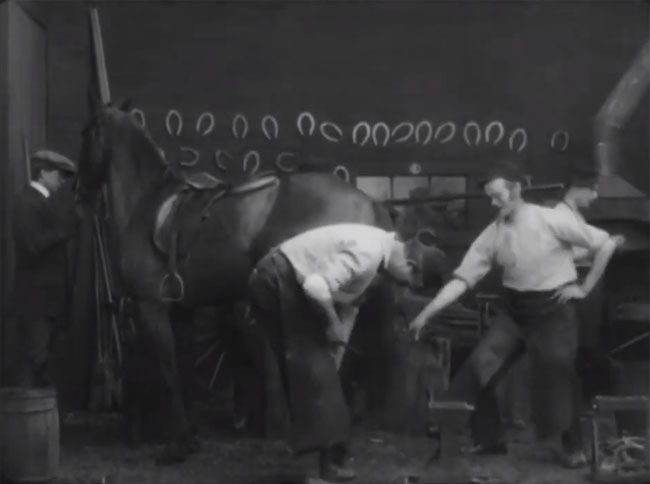
The
Musical Blacksmiths, Kinetophone 1913
Phonofilms
and 'sound-on-film'
In the 1920's "Phonofilms"
were introduced by their inventors Theodore Case and Lee de Forest.
These moving picture shorts were intended to be something that could
be added to the featured movie bill. They were also seen as a novelty
by the public and by many in the silent film industry. The demonstrations
of sound-on-film technology in theatres are reminiscent of the first
demonstrations of Edison's tin-foil phonograph by travelling exhibitors
where paying audiences came to see and hear the new novelty and the
wonder of recorded sound.
The projection and sound
equipment for the Phonofilms had to be installed in a theatre and
few theatres or movie chains invested in permanent systems. A common
demonstration and distribution method, therefore, was for theatres
to have limited engagements, hence the travelling show analogy of
Edison's tin-foil entertainment device. De Forest explained that
"The "phono-film" is adapted
primarily for the reproduction of musical, vaudeville numbers and
solos...De Forest points out that his invention opens the way to scenics
carrying their own music, played by first class orchestras and comedies,
and animated cartoons with bright lines and patter." (Film
Daily, 7 April 1923, pp. 1-2)
For the story of Theodore
Case and the invention of the first commercially successful system
of sound-on-film and the demonstration of the Phonofilms, see the
"digital story-telling adventure" of Cayuga
Museum's Case Research Lab (called the Birthplace of Sound Film
where the Movietone sound-on-film
system was invented in the 1920's).
A 1923 sound-on-film demonstration
using the DeForest PhonoFilms of Eddie Cantor performing a
vaudeville routine can be seen and heard HERE.
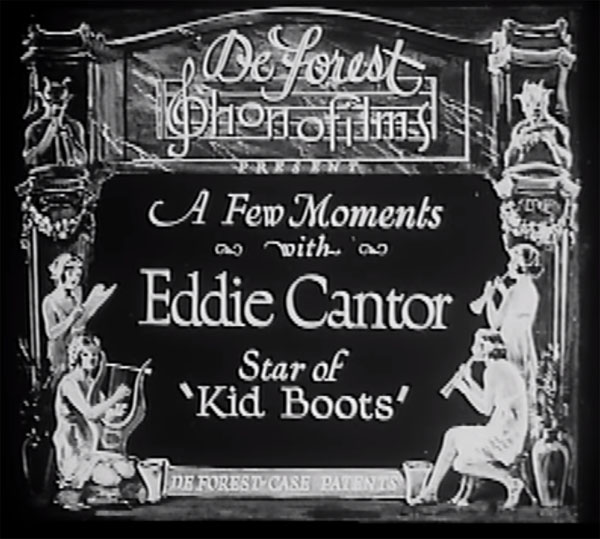
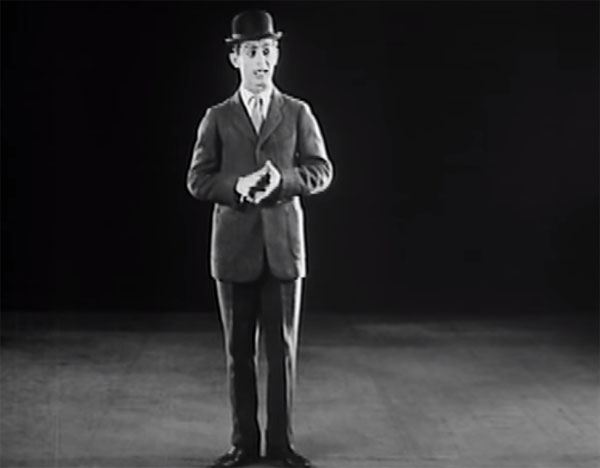
WATCH
"A Few Moments with Eddie Cantor," 1923 DeForest Phonofilms
Anna
Case's Vitaphone film short "La Fiesta"
Anna Case, one of Edison's Tone
Test artists, made a moving picture for the 1915 advertising campaign
of the Edison Diamond Disc Phonograph at the time of Edison's "Voice
of the Violin' moving picture. Unfortunately, that Tone Test film
has been lost. There is, however, a later 1926
Metropolitan opera Vitaphone short (with sound) for "La Fiesta"
with Anna Case performing her song.
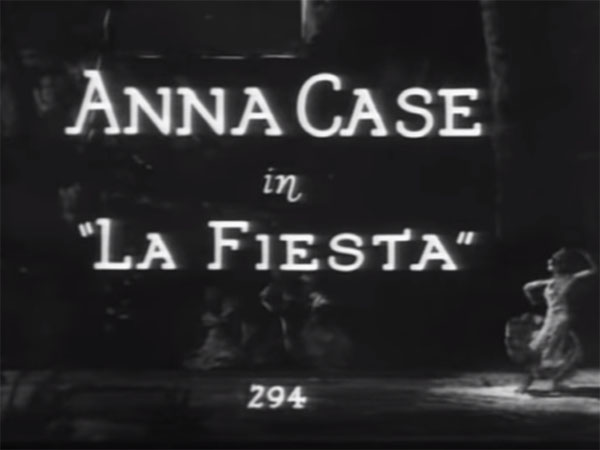
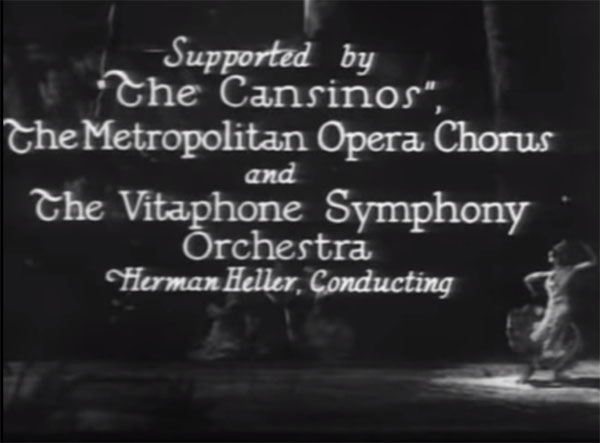
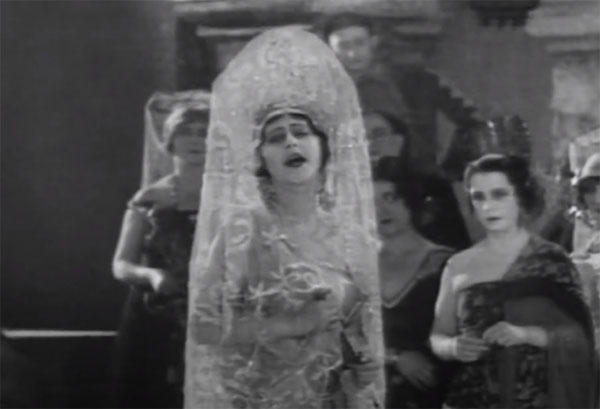
WATCH
Anna Case in this 1926 Vitaphone short for the film "La Fiesta."
Vitaphone Number 294, August 6, 1926.
On August 5, 1926 Warner
Bros. premiered their silent feature "Don Juan" which they
had updated with a symphonic musical score and sound effects. This
was "the first feature-length film to utilize the Vitaphone sound-on-disc
sound system with a synchronized musical score and sound effects,
though it has no spoken dialogue." (Wikipedia)
Vitaphone and "The
Jazz Singer"
"The Jazz Singer"
premiered on October 6, 1927 using The Vitaphone's sound-on-disc sound
system with a synchronized musical score and sound effects, but added
synchronized voice and songs. "The physical presentation of
the film itself was remarkably complex:
Each of Jolson's musical numbers
was mounted on a separate reel with a separate accompanying sound
disc. Even though the film was only eighty-nine minutes long...there
were fifteen reels and fifteen discs to manage, and the projectionist
had to be able to thread the film and cue up the Vitaphone records
very quickly. The least stumble, hesitation, or human error would
result in public and financial humiliation for the company. ( Eyman,
Scott, The Speed of Sound: Hollywood and the Talkie Revolution,
1926–1930. New York: Simon and Schuster. (1997), p. 140. - Wikipedia
With "The Jazz Singer's" popular
audience approval "1927
can be best remembered as the year of sound film, as two dueling systems
rushed to bring in the Talkie Era and dominate the entertainment industry.
For the duel between Movietone vs. Vitaphone see The
Sound Film Wars begin!" - Cayuga Museum.
"The Jazz Singer"
is commonly cited as the beginning of "the Talkies" and
the end of silent movies. As an event in popular culture "The
Talkies" had arrived.
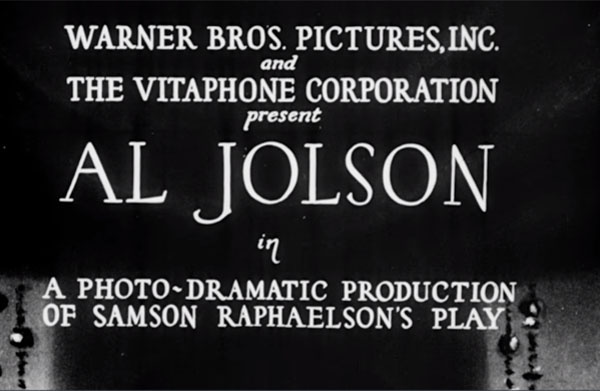
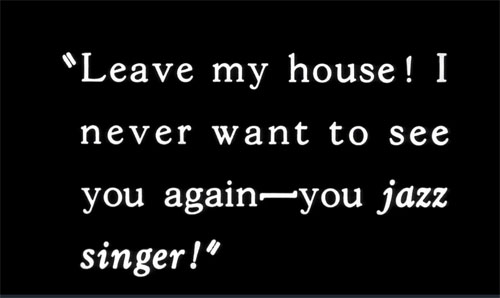
One of the intertitles
providing dialogue for a scene in The Jazz Singer, 1927.
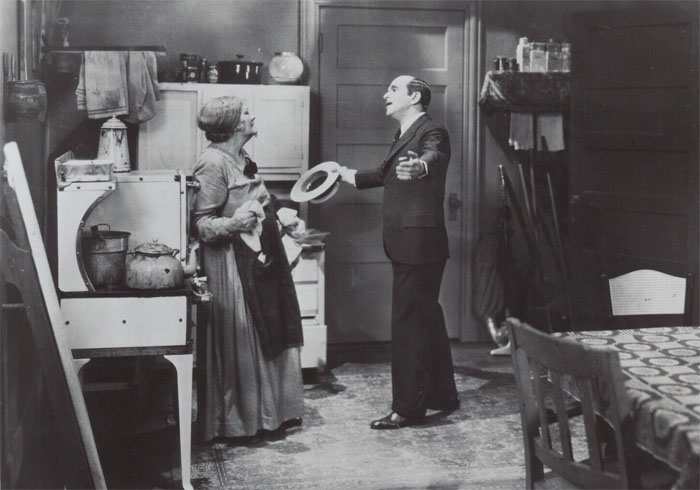
WATCH
The Jazz Singer
As seen by Gaumont's
Chronophone and Edison's Kinetophone, DeForest Phonofilms, Theodore
Case's Movietones, and others demonstrating moving pictures with sound,
The Jazz Singer wasn't the first movie to use recorded sound.
Likewise, The Jazz Singer still used some dialogue intertitles.
And as historian Richard Koszarski' has written, "Silent films
did not disappear overnight, nor did talking films immediately flood
the theaters...." (Koszarski, Richard (1994) [1990]. "An
Evening's Entertainment: The Age of the Silent Feature Picture, 1915–1928."
Berkeley, CA: University of California Press, p. 90).
The Vitaphone's system
of synchronized 'phonorecords' used physical records. But like Edison's
Kinetophone, using records and a mechanical system for playing records
had limitations and the Vitaphone was already being challenged by
other technologies like Movietone's sound-on-film.
By 1931 Vitaphone movies
were no longer being made. Interestingly, sound-on-disc for movies
did return with the 1993 movie "Jurassic Park" and "the
debut of the Digital Theater System (DTS), which stores the soundtrack
on a compact disc and uses a time code to synchronize itself to the
film. Unlike the Vitaphone phonograph record, the DTS compact disc
purportedly suffers no wear when played repeatedly. In a further continuation
of the format wars, DTS is rivalled by Dolby Systems’ AC-3, a digital
sound-on-film technology. ("Vitaphone
Vaudeville, 1926-1930." Essay by Richard Hildreth
for the San Francisco Silent Film Festival, Winter 2007.)
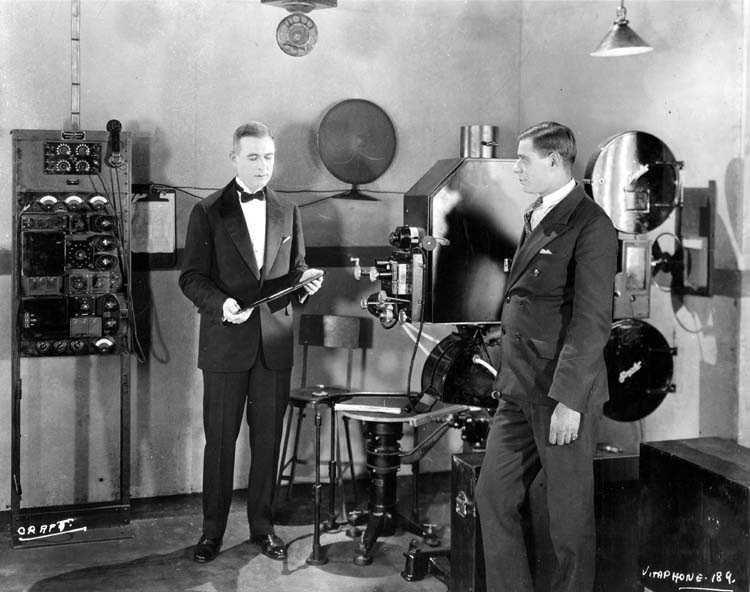
A Vitaphone projection
system was demonstrated in 1926. Engineer E. B. Craft holds a soundtrack
disc. The turntable, on a massive tripod base, is at lower center.
Wikipedia
Were Silent Movies Really
Silent?
As the many examples have
shown, The Jazz Singer, often called the first "talkie,"
was not the first film to synchronize with sound or to include spoken
dialogue. Also, as Rick Altman has documented, the idea is incorrect
that all previous movies before the 1927 The Jazz Singer were
"silent." Not only did many sounds accompany the 'silent
movies' a "variety of sound strategies" had been
used.
During the nickelodeon period
prior to 1910, this variety reached its zenith, with theaters often
deploying half a dozen competing sound strategies—from carnival-like
music in the street, automatic pianos at the rear of the theater,
and small orchestras in the pit to lecturers, synchronized sound
systems, and voices behind the screen. During this period, musical
accompaniment had not yet begun to support the story and its emotions
as it would in later years."
But in the 1910s, film sound acquiesced
to the demands of captains of the burgeoning cinema industry, who
successfully argued that accompaniment should enhance the film's
narrative and emotional content rather than score points by burlesquing
or "kidding" the film. The large theaters and blockbuster productions
of the mid-1910s provided a perfect crucible for new instruments,
new music-publication projects, and the development of a new style
of film music. From that moment on, film music would become an integral
part of the film rather than its adversary, and a new style of cinematic
sound would favor accompaniment that worked in concert with cinematic
storytelling. Source: Rick
Altman, Silent Film Sound, Columbia University Press, 2007
- Columbia
University Press Website
Drums and Pianos
The following 1909 article from the
trade magazine "The Talking Machine World" provides a timeline
for different "sound strategies" tried out by some movie
picture theatres - the player piano, the phonograph, live singers,
a real pianist, a four or five piece orchestra for the bigger theatres,
and when too expensive, back to simply a piano and drum.
"When the five cent theatres
first began to blossom in Chicago, their musical equipment consisted,
as a rule, of an electric piano, which kept things stirred up during
the intermission, and a talking machine which did the illustrated
song stunt."
But in the latest development the article
explains how there is now "an immense demand for drums and traps."
The advantages of having a drummer are
many: plenty of noise with imitations of various rough house stunts
depicted by the films, such as collapse of a building, the tumble
of a hero from the seventh story window, etc. The patter of a horse's
hoofs...the shuffling of feet...the squeak of a pig,
etc... "Practically all the shows are using the drummer as the
principal part of their equipment now and he keeps us wiring east
to keep up with the demand."
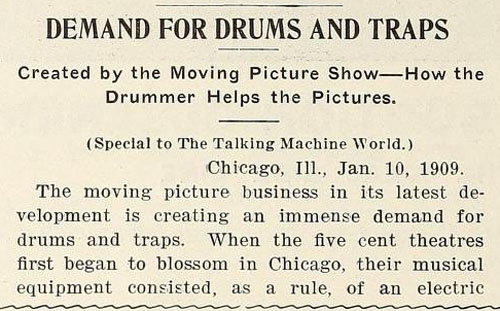
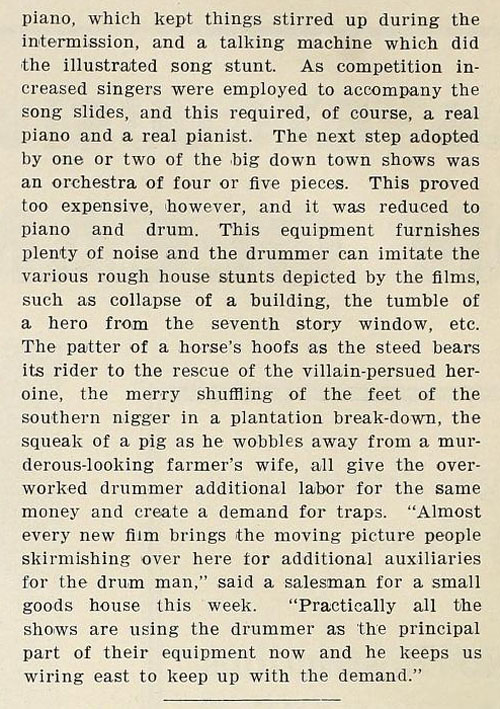
"How the
Drummer helps the Pictures," The Talking Machine World,
January 1909 (Disclaimer)
Pipe Organ used with
Biblical, mythological and historical subjects in movies.
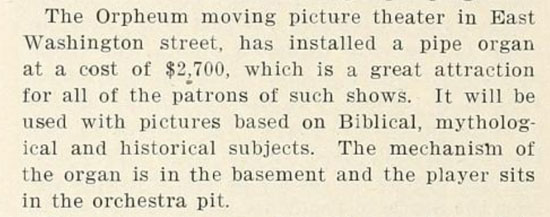
Orpheum moving picture
theatre pipe organ, The Talking Machine World, April 1909
In the September 1915 issue of Photoplay's
"Close-Ups by Editor" section the following prediction was
made about the future of combining film and great music:
"I believe that "The Birth
of a Nation" is worth $2, and I believe that there will be other
screen plays worth $2 — perhaps... there will be wonderful combinations
of shadow-spectacle and master-music for which $5, or even more,
may be successfully asked."
Large and small orchestras, organs,
pianos, percussions and living voices provided most of the 'sound'
for the silent films.
The phonograph and its records, however,
have inserted into some movie scenes which is the focus of this Phonographia
gallery.
Phonographs in Movie
Houses
The following are examples
of movies where phonograph music was used in a movie house. Most of
these examples were the result of a local phonograph dealer providing
a phonograph and record related to a movie scene. Adding phonograph
sounds to theatre movies was viewed by the talking machine industry
and local phonograph dealers as an 'immense' advertising opportunity
in "wedding the talking machine" to the "movie theatre
and its program."
When there was a "wedding
of the talking machine" to the movie, however, it seems to have
involved an insertion or the stoppage of the film at the appropriate
(or in some cases "inappropriate) time in the movie in order
to play a phonograph record. That insertion wasn't always smoothly
done.
Talking Pictures with
the Phonograph humorously Out of Synch.
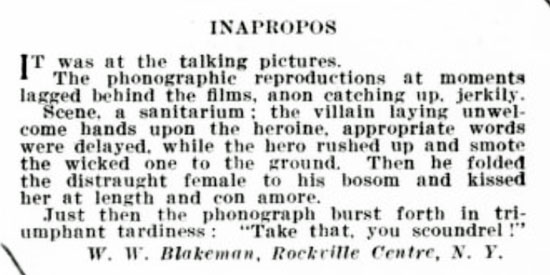
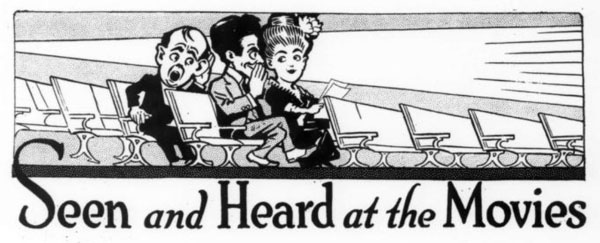
The Photoplay Magazine,
April 1915
"The Voice of the
Violin" (1915)
The Thomas A. Edison movie,
The Voice of the Violin, was a silent film created to promote
the the Edison Diamond Disc Phonograph in 1915.
Two stars of the show were
the Edison Diamond Disc Louis XV Model B-375 Phonograph (1912 - 1915)
and the Edison Diamond Disc record "Feast of the Flowers."
This movie was intended to be used by Edison dealers and shown in
local theatres as an advertisement for the Edison Diamond Disc and
its "Re-created" music of the Edison Records. The violin
piece "Feast of the Flowers" was the featured Edison record
in the movie which was also surely played as part of the 'silent'
movie and was also important for its role in the story of reuniting
a family.
LISTEN
to "Feast of the Flowers" performed by American Symphony
Orchestra, Edison Diamond Disc Record 50118-R (Source: DAHR
and UCSB Library).
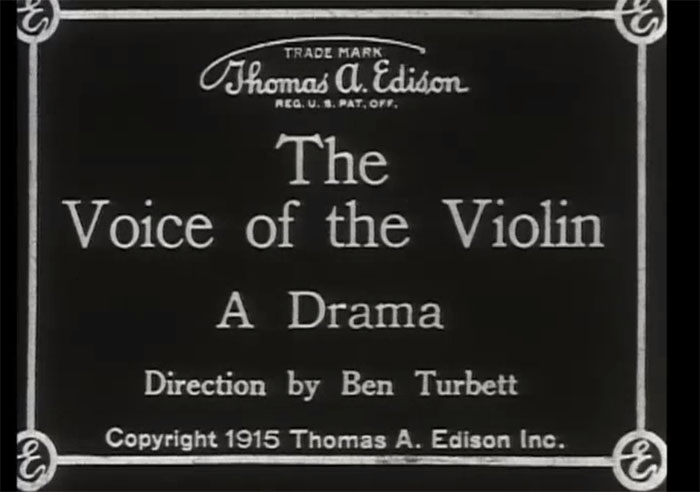
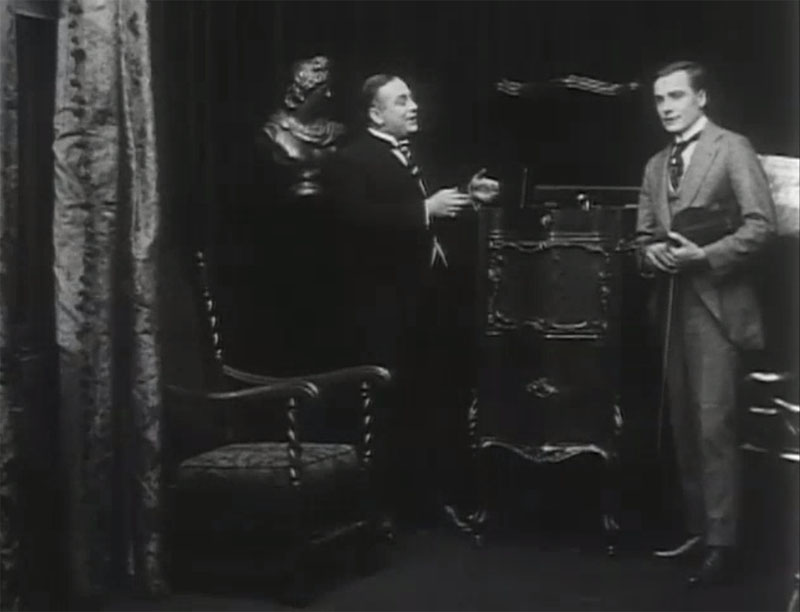
Listening to the
Edison Diamond Disc Louis XV Model A-375 Phonograph in "The
Voice of the Violin."
See Phonographia's "Voice
of the Violin" for more details about the movie, screenshots
from key scenes, and a link to the 20 minute movie which can be watched
courtesy of the Library
of Congress.
"The Stolen Voice."
(1916)
A "Victrola"
provided an "aria" and represented the voice of one of the
movie actors, Robert Warwick, in the silent 1916 movie "The
Stolen Voice."
The Talking Machine
World in 1916 reported seeing an article in a Chicago piano trade
publication which described a Buffalo, New York motion picture house
pausing the film so that a Victrola could quickly be moved into place,
and then restarting the film with the introduction of the talking
machine in the picture to which the "audience enthusiastically
applauded," an "aria from 'Pagliacci' was played and sung."

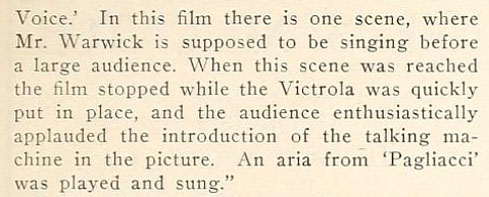
The Talking Machine
World, May 15, 1916
LISTEN
to the aria “Vesti la giubba,” sung by Enrico Caruso, Victor 12"
Red Seal Record 88061, recorded March 17, 1907 Giovannoni Collection
at the Library of Congress).
Note: The writer of this Talking
Machine World article had titled it "Can You Solve this
Puzzle? We Have Given Up," not because he was surprised
by a Victrola being used to provide the voice of one of the movies
actors. Instead, the puzzle was because there had been no
merger between Edison and Columbia (the maker of Garfonola's), and
there was no such machine as "a high-class Edison Grafonola."
To add further confusion, this phonograph was also later identified
as "the Victrola" (yet another company's machine).
TMW humorously answered the question
of why three makers of phonographs had been named: "Perhaps
it's an effort to be impartial, but in that case what about the
Pathe, the Sonora and a dozen others?" More likely, they
surmised, it was because the editor of the piano trade publication
was "careless in reading his clippings."
"A Stolen Voice. (1916)
The Edison Phonograph Monthly,
August 1916, provided more accurate details than were reported by
The Talking Machine World the previous month (see above) and
solved its "puzzle." In this presentation of "A Stolen
Voice," just as the scene commences where Mr. Warcik is shown
singing the lights were turned out, the projector stopped, and an
aria from "Pagliacci" came from an Edison phonograph on
the stage. When the song ended the picture again was flashed on the
screen and the performance continued."
It was then noted that this "new
combination of the phonograph and the motion picture" can
be "used to advantage with many picture plays and managers
should be interested in this new and effective use of the phonograph
in connection with the movies."
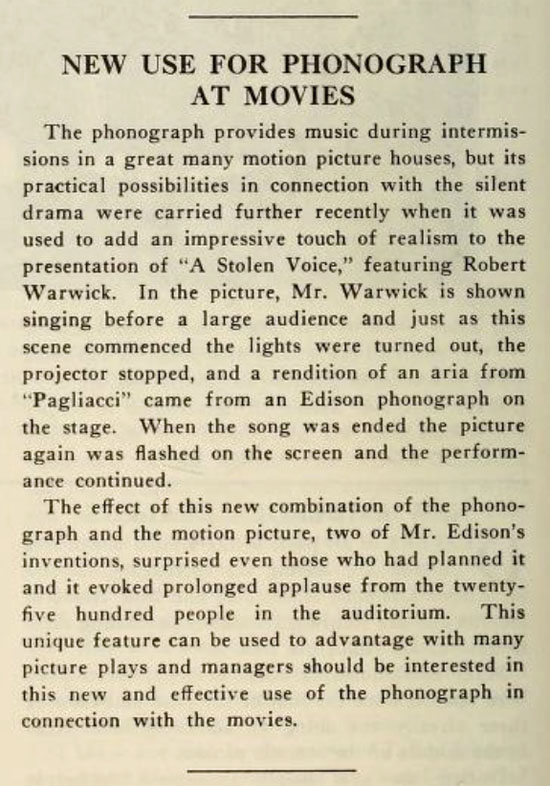
"The phonograph
provides music during intermissions in a great many motion pictures
houses..." The Edison Phonograph Monthly, August 1916.
"Why Change
Your Wife." (1920)
- The movie insertion of the Victrola and two recorded songs.
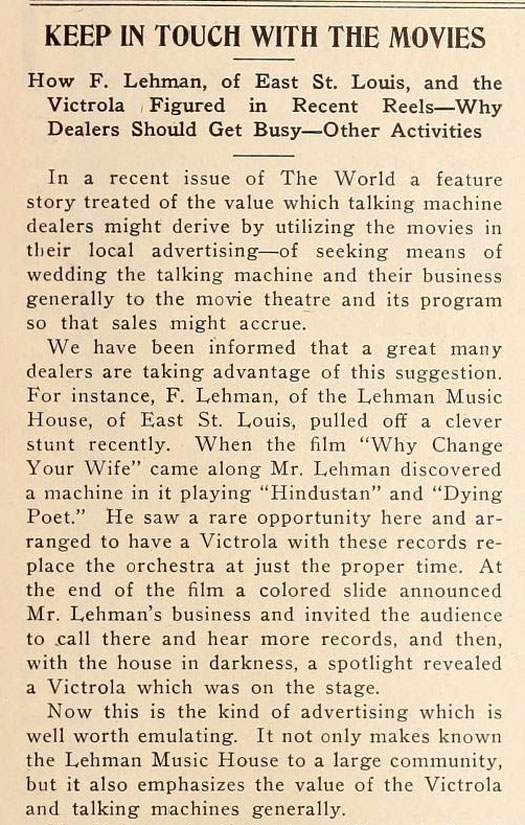
The Talking Machine
World, June 15, 1920, p. 3.
The Lehman Music house
in St. Louis provided a Victrola and the Victor records "Hindustan"
and "Dying Poet" to a movie theatre after Mr. Lehman saw
the Cecil B. DeMille film "Why Change Your Wife." In that
film Lehman had seen a machine playing those songs and realized the
advertising opportunity he would have if he could replace the orchestra
at just the proper time with the Victrola music.
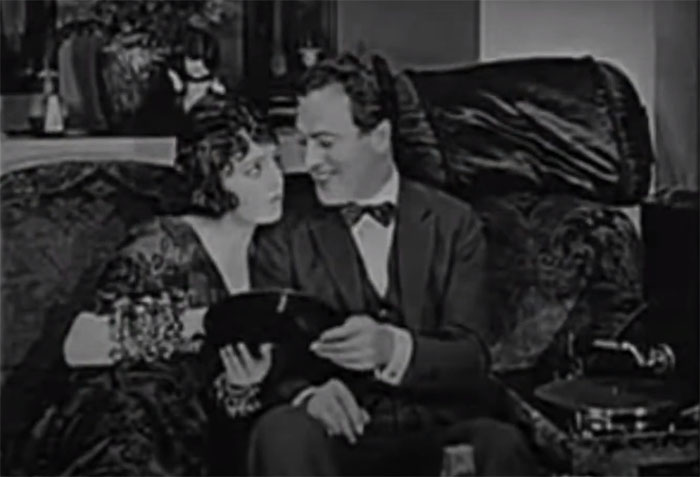
Screenshot of couple looking
at Victor Record 18623-A "Give Me a Smile and Kiss" and
then putting stylus onto the record player to their right. A close-up
of the Victor record is also shown in the movie.
LISTEN
to Victor 18623-A "Give me a smile and kiss" / John
Steel (Black label (popular) 10-in. double-faced) recorded on September
20, 1919 and released on September 29, 1919. (Source: DAHR Recording
from Library of Congress).
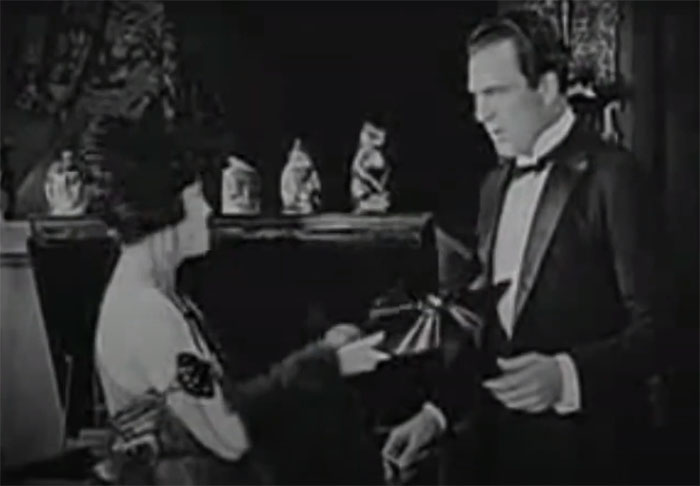
Screenshot of woman upset
with the record that was playing when she entered the room. She then
proceeded to break the Victor Record 35467-A "The Dying Poet""
in half.
LISTEN
to Victor Record 35467-A "The Dying Poet," Sousa's Band,
recording May 14, 1912 (Courtesy Library of Congress).
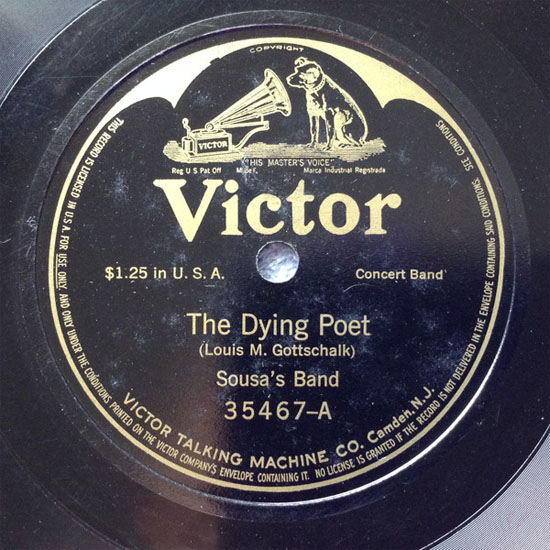
In another scene Victor
Record 18507-A "Hindustan" is shown for the audience to
read its title, and then it was played.
LISTEN
to Victor 18507-A "Hindustan" performed by Joseph C.
Smith's Orchestra, (Black label (popular) 10-in. double-faced) released
on July 17, 1918 (DAHR and Recording David Giovannoni Collection).
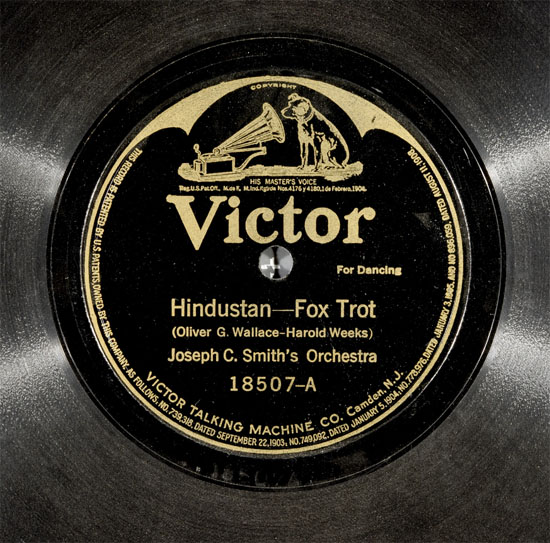
Lehman also created a colored
slide which invited the audience to visit his store and hear more
records. With the house in darkness, Lehman also arranged to have
a spotlight reveal a Victrola which was on the stage. "Now this
is the kind of advertising which is well worth emulating" noted
The Talking Machine World.
For other glass slides
being used for phonograph advertising in theatres, see Phonographia's
Movie
Slides Advertising the Phonograph.
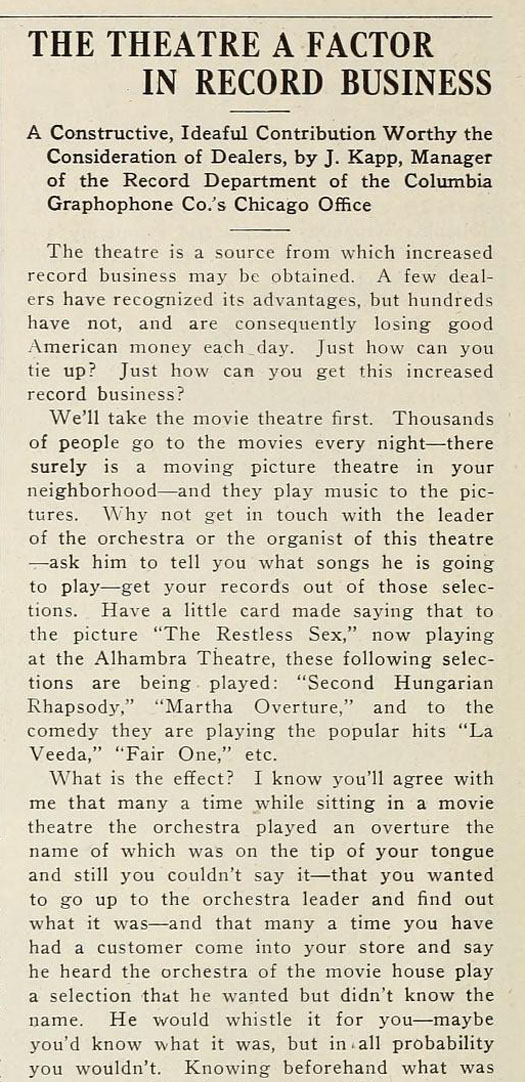
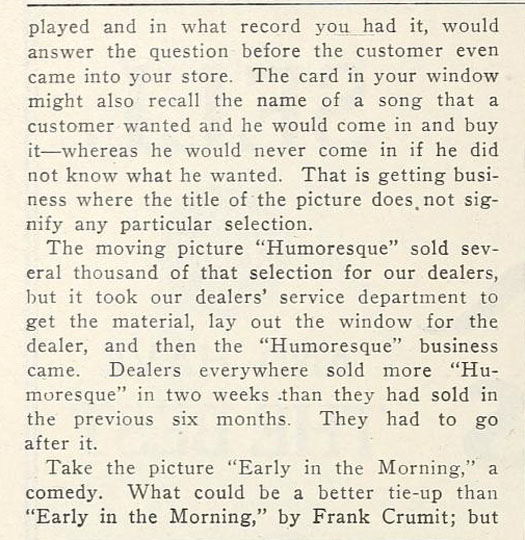
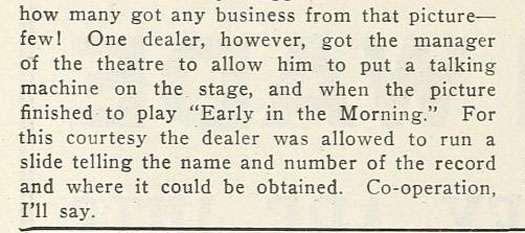
"Many customers want
a record to remember the show. It is through the medium of the record
that they remember the show." The
Talking Machine World, December
15, 1920, pp.150,
152.
"The Barbarian."
(1921) and "Our Yesterdays."
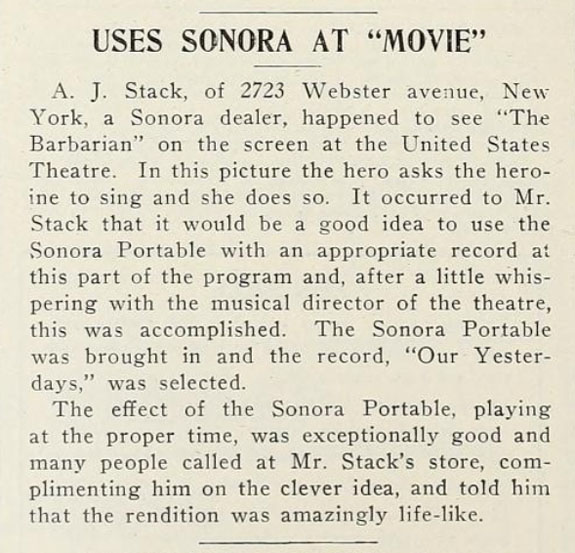
A Sonora dealer provided
a Sonora Portable to a theatre to use in the movie "The Barbarian"
with the record "Our Yesterdays" to be played "at the
proper time", The Talking
Machine World, May 15, 1921.
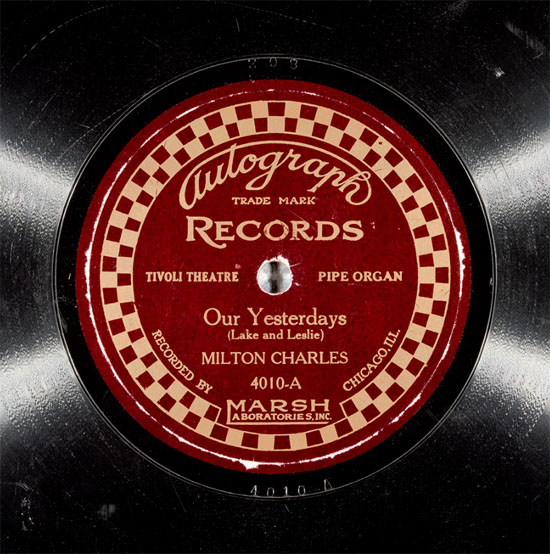
LISTEN
to "Our Yesterdays" by Milton Charles played on Tivoli
Theatre Pipe Organ, Autograph Records, 4010-A, 1925. (David Giovannoni
Collection).
For an interesting story
about the desmise of the theatre movie organ after 1927 and the history
of one of those Wurlitzers which was saved, see The
Hardman Studio Wurlitzer The History of the Theatre Organ.
"Molly O"
(1922) and "Molly O."
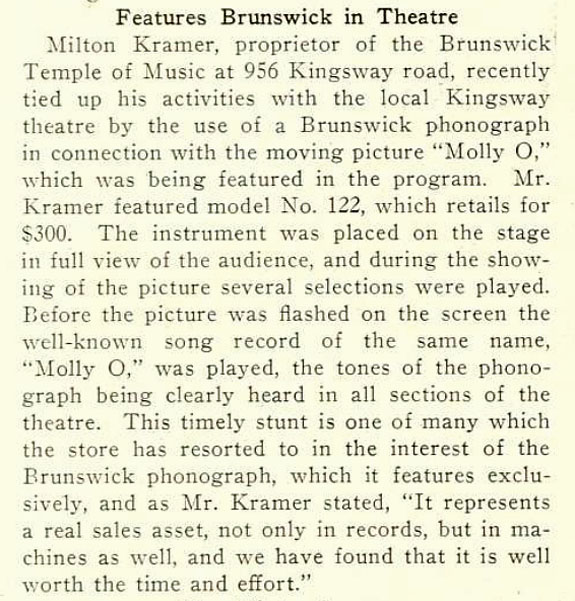
Brunswick phonograph
in moving picture theatre, The Talking Machine World, March
15, 1922
"A Brunswick phonograph
was provided the the Brunswick Temple of Music store in connection
with the moving picture "Molly O," which was being featured
in the program. Several selections were played and before the picture
was flashed on the screen the well-known song record of the same name,
"Molly O," was played."
"Molly O (I Love You)"
Lyric by James C. Emery. Music by Norman McNeil, Waterson, Berlin
& Snyder Co., Music Publishers, New York, 1921 (Lester S. Levy Sheet
Music Collection, Johns Hopkins).
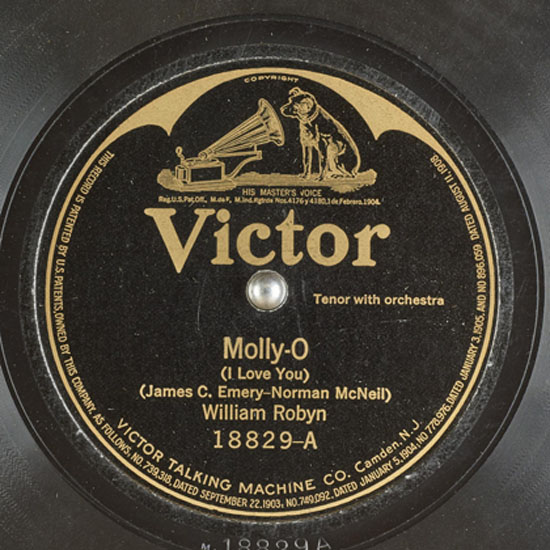
LISTEN
to "Molly-O (I Love You)" by William Robyn, Record 18829-A,
recorded 17Oct2021 (DAHR and Library of Congress).
"Honors Are Even"
(1923) - Victrola plays "La Golondrina
during one of the scenes..."
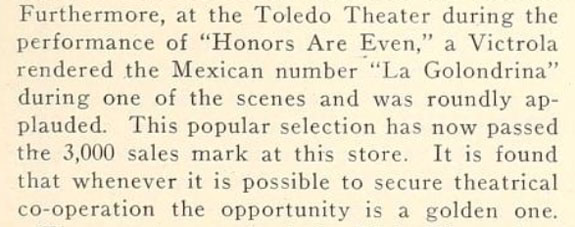
Victrola played "La
Golondrina" at the Toldeo Theatre during performance of "Honors
Are Even," The Talking Machine World, May 15, 1923. Note:
"Honors Are Even" opened on Broadway August 10, 1921, however,
no movie has been found.
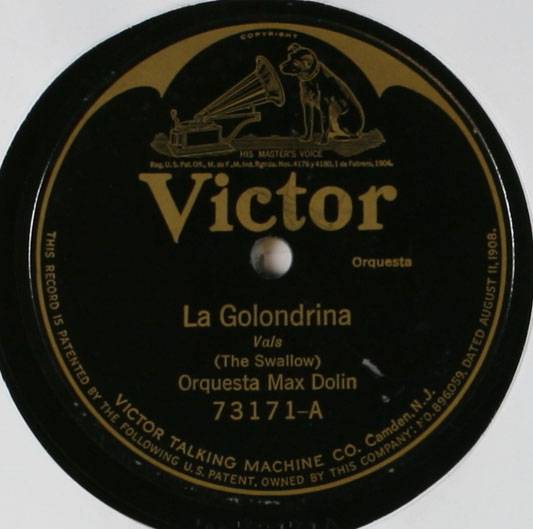
LISTEN
to "La Golondrina" by Max Dolin Orchestra, Victor Record
73171-A, recorded November 22, 1921 (DAHR
- Recording UCSB).
Other
Factolas related to Music for the Movies
ENRICO CARUSO to become
film actor - "Attend a Caruso picture, with your phonograph
in your lap."
In Photoplay Magazine,
November 1915, there is an announcement that Enrico Caruso, the famous
tenor, is "to become a film actor... His first picture, from
the Pallas studios, will be Booth Tarkington’s “The Gentleman from
Indiana.” Arthur Johnson's argued that there are countless thousands
all over the world so eager for a sight of Caruso that his pantomime
will be welcome, even though the voix d’or is silent. Receipt for
an orgy: attend a Caruso picture, with your phonograph in your lap."
Geraldine Farrar uses
Bizet's music during the filming
of her movie "Carmen."
In Photoplay Magazine,
August 1915, Geraldine Farrar reported that Bizet's music would be
used while her new movie "Carmen" was being filmed. "When
my ‘Carmen’ film is taken at Lasky’s,” said she, “it will be to the
accompaniment of Bizet’s music... Bizet’s wonderful music makes me
a Russian or a Spaniard, whichever you will, above my belt. Without
it I am cramped, slow, heavy. So while the crank is inturning ‘Carmen,’
I’m going to have the music under way. I want you to see ‘Carmen’
in the bright shadows —not ‘Jerry’ Farrar. Understand?”
Film
Scores for Silent Films - The Library of Congress (its digital
collection includes over 3,000 items published or created for use
in silent film accompaniment between 1904 - 1927.)
The Music Division's
collection of music for silent film can be divided into four different
categories, the vast majority of which can be found under four different
call numbers. The four categories are:
Film Scores: written for specific
films, which can include full scores, piano scores, and sets of
orchestral parts
Cue sheets: served as musical primers
for film accompaniment, may or may not include music incipits
Photoplay albums: stock music written
specifically for use in accompanying silent film, which can include
piano scores and sets of parts
Salon orchestra music: music often
used in silent film accompaniment, but not originally published
with that use in mind, which primarily consists of sets of parts.
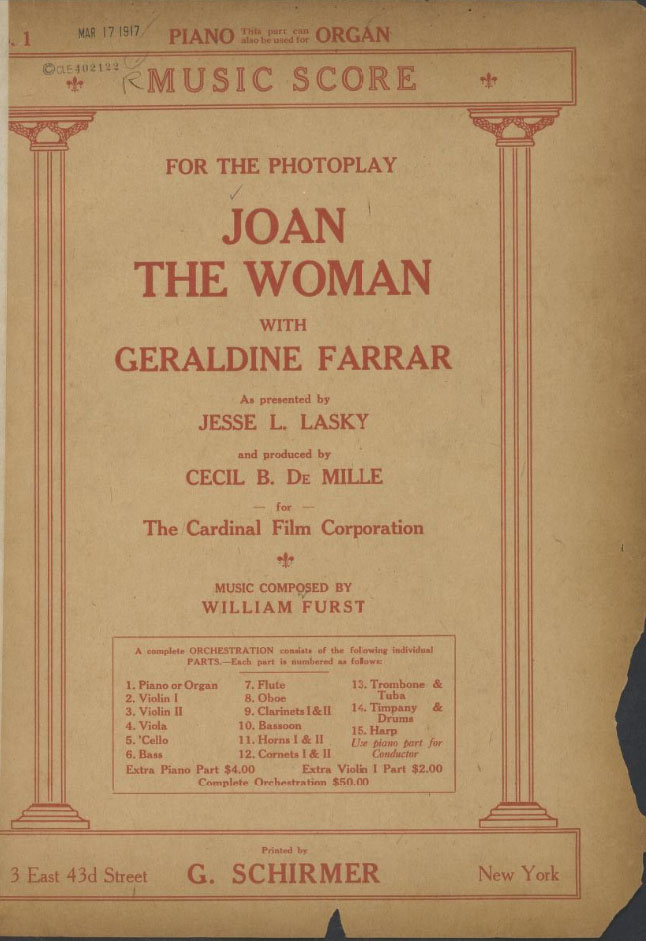
Music score for the photoplay
Joan the Woman with Geraldine Ferrar as presented by Jesse L.
Lasky and produced by Cecil B. De Mille for the Cardinal Film Corporation,
New York : G. Schirmer, [1917]. (Library of Congress: Silent Film
Scores and Arrangements).
"The Thief of Bagdad"
As an example of a major
silent picture film score, the 1924 "The Thief of Bagdad"
starring Douglas Fairbanks has a Reconstructed
Film Score (from the original film score) which has been recorded
for the first time by the Frankfurt Radio Symphony Orchestra, Mark
Fitz-Gerald, First Hand Records ©2022 and can be heard on Spotify,
et al.
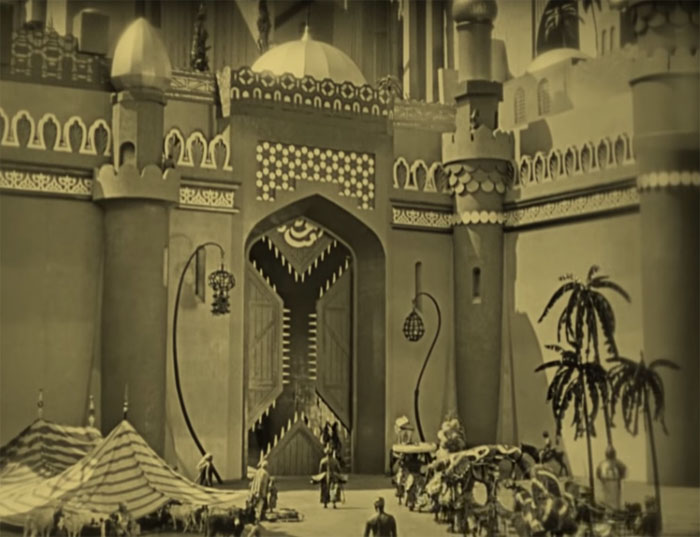
WATCH
the Thief of Bagdad Trailer from
Cohen Media Group
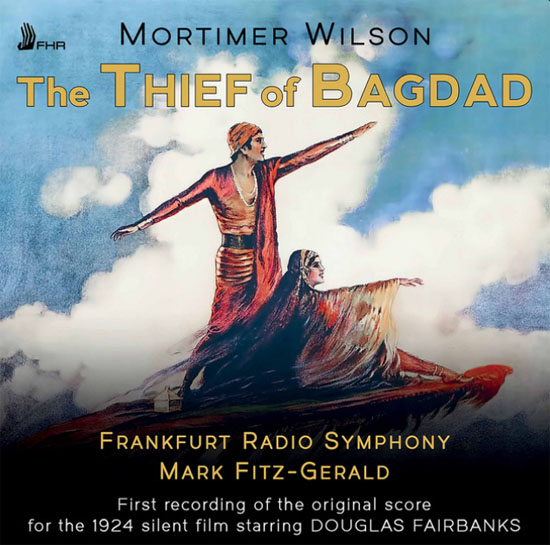
LISTEN
to the 1924 Thief of Bagdad (Spotify)
A Footnote on Silent
Movies: There is no "Silent" Drama.
An article in Photoplay
Magazine, September 1915 starts with the question: Is "silent
drama" silent? If not, why, how and to what extent is it vocal?
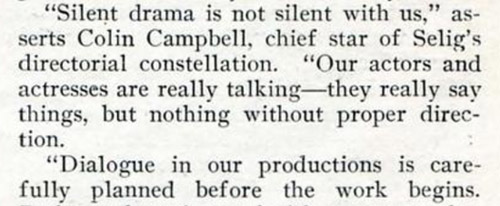
Photoplay Magazine,
September 1915
The premise of this article
is that the actors are following scripts and are actually talking
-- and that the audience recognizes they are talking because of the
intertitles, the action and context of the scenes, and the words being
'spoken' by the actors in the movie. The article notes that "The
public is rapidly and unconsciously acquiring a very fair degree of
proficiency in lip-reading, and a false speech will be subconsciously
noted and resented, and the matter is of too great importance to depend
upon a chance selection of words."
"During the early days of picturemaking
little attention was paid to dialogue, with the result that the
action lost much of its meaning and continuity. It wandered. Frequently
nonsense or profanity was introduced."
Dialogue, it was being
said, was used in silent movies and that meant they weren't really
"silent."
Perhaps Photoplay's
further example could have been that seeing dialogue in silent movies
was like reading a book, with the voices in each case being "heard"
in the mind -- either by reading the dialogue in the context of the
book's story or by reading the lips, intertitles, and emotions/action
in the movie.
The following are some
of Photoplay Magazine's conclusions regarding dialogue being
used in the "no silent" movies of 1915:
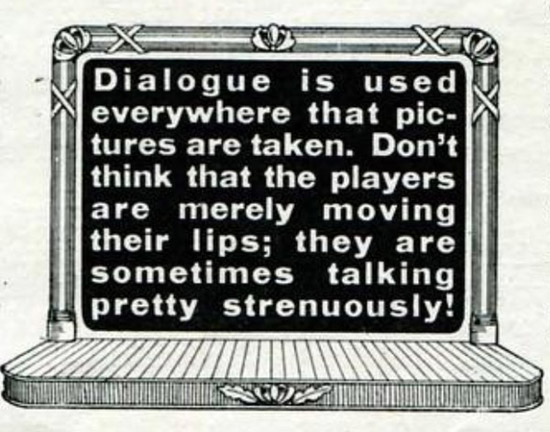
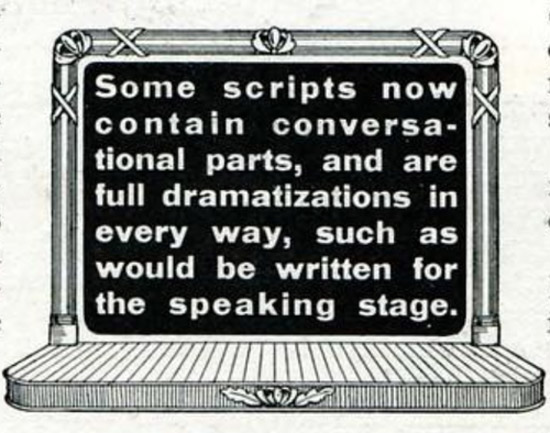
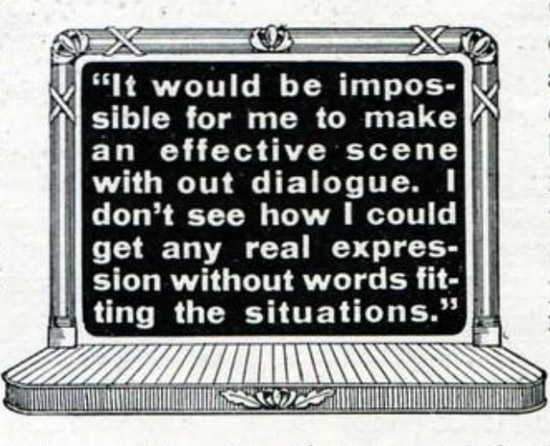
Photoplay Magazine,
September 1915, pp. 73-76
Movie
related songs and performances pre-1929.
"At
the Movies" by Ethel C. Olson, Victor 10" Ethnic Norwegian
Series 77251, Comic Monologue, recorded November 6, 1923 (David Giovannoni
Collection, i78s.org).
At
the Ten-Cent Movie Show by Walter Van Brunt, Silvertone 10"
Record 38719 (Columbia Client), recorded on March 21, 1913. (Ibid.)
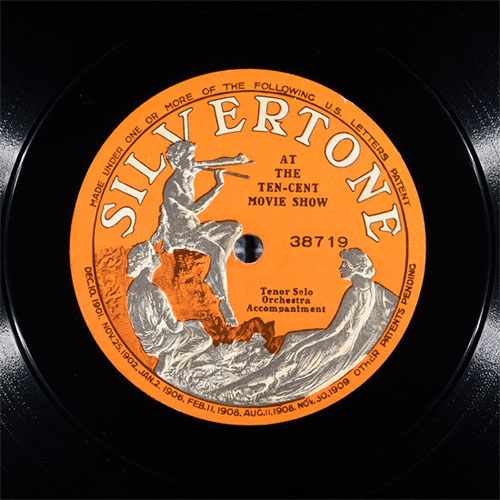
"Echoes
from the Movies" Accordian played by Pietro J. Frosini, Edison
Blue Amberol, Record 2531, recorded October 31, 1914. (Ibid.)
"Ever
Since the Movies Learned to Talk" from Whoopee by Billy Murray,
Harmony 10" 784-H, recorded November 15, 1928 (Ryan Barna Collection,
i78s.org).
"He's
working in the movies now" by Billy Murray, Edison Record
2335, 4-minute celluloid cylinder, recorded March 27, 1914 (David
Giovannoni Collection).
"Since
Mother Goes to the Movie Shows" by Billy Murray, Edison Blue
Amberol, Record 2920, recorded February 3, 1916 (EPM New Releases
for August 1916). (Ibid.)
The following are a few
examples of recorded music that have become well-known by being associated
with respective movies.
Best Selling Soundtrack Albums
(as of January 1, 2023) - See Wikipedia
for latest lists.
1992 The Bodyguard
by Whitney Houston & Various
1977 Saturday Night
Fever, by Bee Gees & Various
1987 Dirty Dancing
by Various
1997 Titanic: Music
from the Motion Picture by James Horner & Various
1978 Grease: The Original
Soundtrack from the Motion Picture by Various
Best Streaming Soundtrack
Albums (as of January 1, 2023) - See Wikipedia
for latest lists.
2015 Furious 7 ("See
You Again") by Wiz Khalifa, Charlie Puth
2018 A Star Is Born
by Lady Gaga, Bradley Cooper
2017 The Greatest Showman
by Hugh Jackman, Keala Settle, Zac Efron, Zendaya, Various
2013 Frozen ("Let
It Go") by Robert Lopez, Kristen Anderson-Lopez, Idina Menzel, Kristen
Bell
2016 Moana by Lin-Manuel
Miranda, Mark Mancina, Opetaia Foa'i, Auli'i Cravalho, Alessia Cara
For examples of popular
Movie Songs identified in 2022, see Best
Movie Songs - 50 Themes from Hollywood Film Classics.
A Friend of the Phonograph's
memories of sound track record albums.
Growing up in the 1950's and 1960's
our family saw several movies at the Omaha Cinerama (where souvenirs
and memorabilia for some of the movies were also sold). Two albums
that my parents purchased because of going to the movies were Michael
Todd's "Around the World in 80 Days" in Todd-AO and "How
the West Was Won."
Our movie soundtrack LP library
also included "The Great Race" and "The Sound of
Music." (DB,
2004)
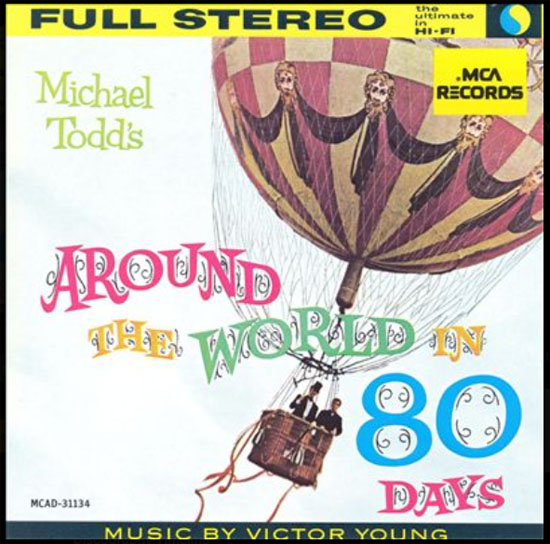
"Around the World
in 80 Days," MCA Records, 1956
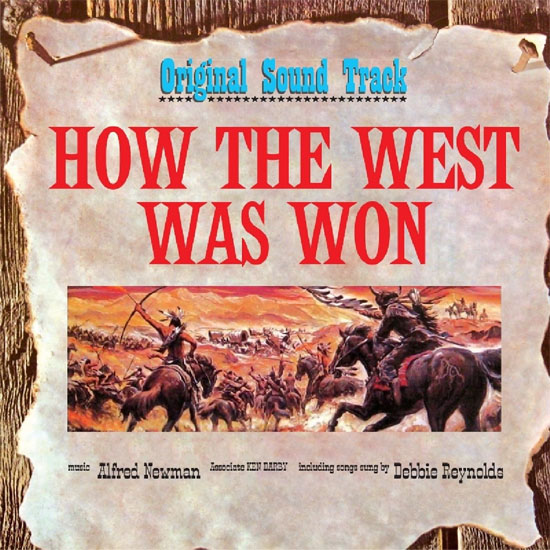
"How the West Was
Won," Original Sound Track, MGM Records, 1963
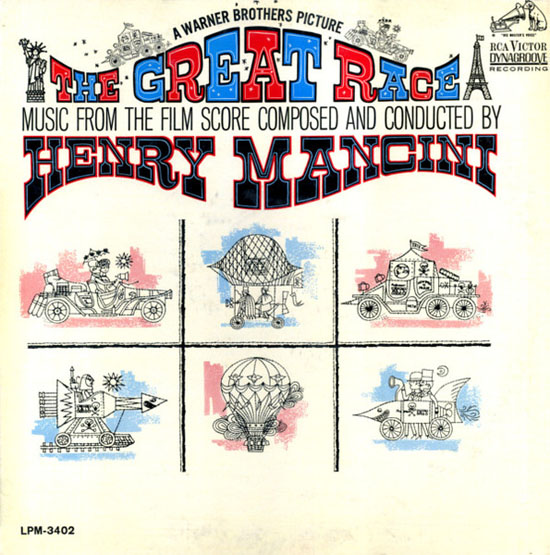
"The Great Race,"
RCA Victor Dynagroove Recording, Music from the Film Score, 1965
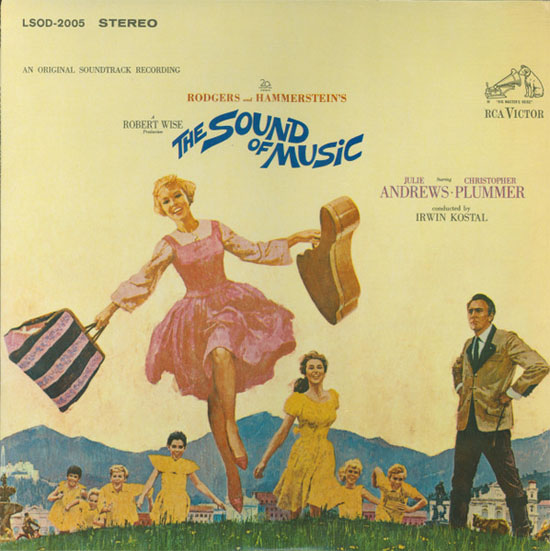
"The Sound of Music,"
RCA Victor Stereo, An Original Soundtrack Recording, 1965
Sound Recordings - Copyright
Registration for Sound Recordings -- (Copywrite
Office Circular 56 Revised
03/2021 - Copyright.gov)
Sound Recordings Distinguished
from the Sounds Accompanying a Motion Picture
There is a legal distinction
between a sound recording and the soundtrack for a motion picture
or other audiovisual work. The Copyright Act states that “sounds accompanying
a motion picture or audiovisual work” are not sound recordings. These
types of sounds are considered part of the motion picture or audiovisual
work. Common examples of works that do not qualify as sound recordings
include:
• The soundtrack for a cartoon, documentary,
or major motion picture.
• The soundtrack for an online video,
music video, or concert video.
• A
musical performance during a scene or during the credits for a motion
picture.
Sound Recordings Distinguished
from Phonorecords A sound recording is not the same as a phonorecord.
A phonorecord is the statutory term for a physical object that contains
a sound recording, such as a digital audio file, a compact disc, or
an LP. The term “phonorecord” includes any type of object that may
be used to store a sound recording, including digital formats such
as .mp3 and .wav files.
Sound Recordings Distinguished
from Phonorecords
A sound recording is not
the same as a phonorecord. A phonorecord is the statutory term for
a physical object that contains a sound recording, such as a digital
audio file, a compact disc, or an LP. The term “phonorecord” includes
any type of object that may be used to store a sound recording, including
digital formats such as .mp3 and .wav files.
Movie
Pictorial Magazine, October 1, 1914 - "The
Crying Need of The Silent Drama"
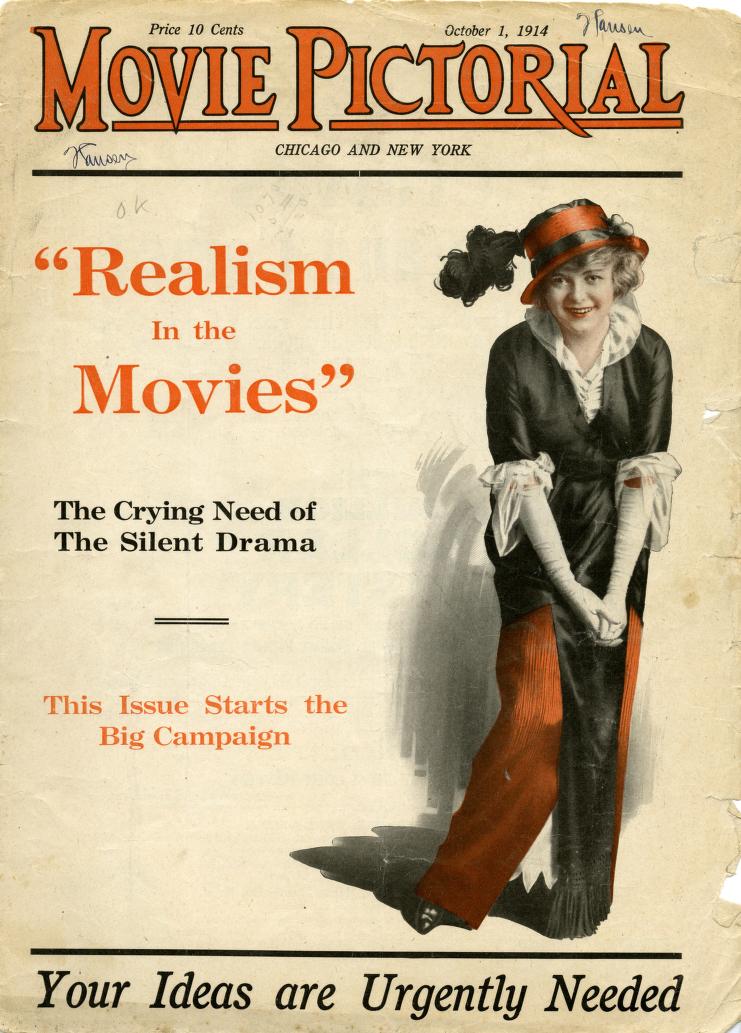
Movie Pictorial,
October 1, 1914
Movie Pictorial's
New Department - THE MUSIC STORY - A Department for
Musical Interpretation of Moving Pictures
The Lack of Harmony
between the visual messages and music messages of the movie
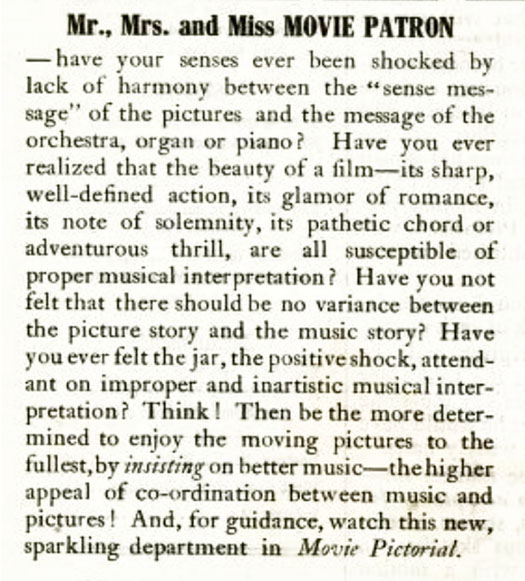
Movie patrons must insisting
on better music "to enjoy moving pictures to the fullest"
and higher co-ordination between music and pictures! "How to
Make Music Tell the Story of the Films, Movie Pictorial,
October 1, 1914
Film
Players Herald Tradelasts
"Things About My Theatre I Like and Dislike"
Disconnects Between
Movies and their Music
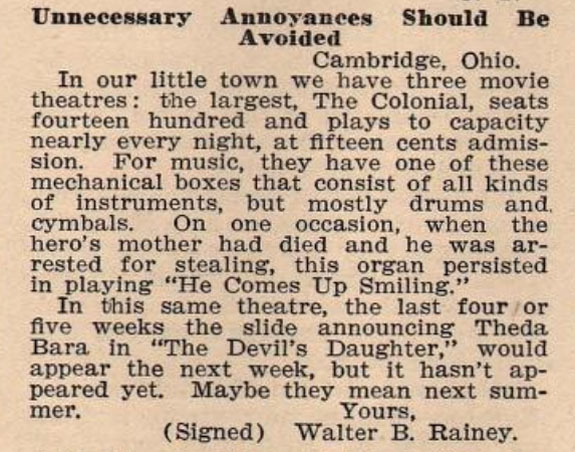
"Mechanical boxes
for music" plays inappropriate song. Film Players Herald,
February 1916
"Canned music grinder"
is inexcusable for "Carmen and Geraldine Farrar's film as "Carmen."
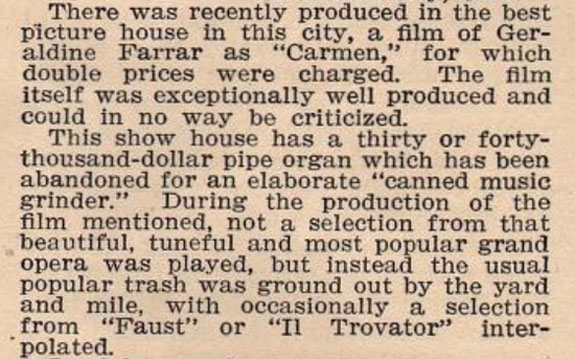
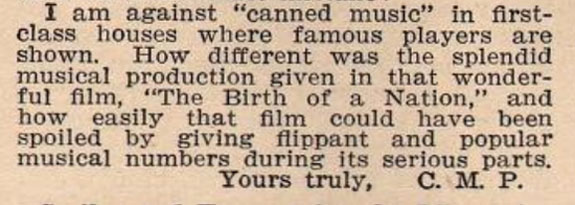
Geraldine Farrar
as "Carmen." Film
Players Herald, February 1, 1916
Resources
This gallery is a very
limited scrapbook of the history of silent and talking movies, soundtracks,
and other movie connections with the phonograph and recorded sound.
For a comprehensive examination with wonderful illustrations related
to "all aspects of sound practices during the silent film period
in America" see Rick Altman's "Silent Film Sound,"
Columbia University Press, 2004.
For more details on Phonofilms
and MovieTone's sound-on-film system see Cayuga
Museum of History & Art: "Inventing the 20's: Recording Sound
on Film." Also see,
Encyclopedia.com's "Virtual
Broadway, Virtual Orchestra: De Forest And Vitaphone."
For a list of movies where
phonographs appeared in a movie, see Phonographia's
Phonographs in the Movies.
For examples of video game
soundtracks on LPs, see Phonographia's "Video
Game Soundtracks."
For a May 2024 sampling
of The New York Time's readers favorite soundtracks, see "Hundreds
of Readers Told Us Their Favorite Soundtracks. Which Came Out on Top?"
